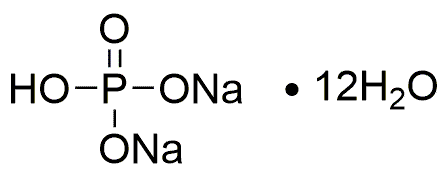Sodium phosphate dibasic dodecahydrate is widely utilized in research focused on:
- Biological Buffering: This compound is commonly used in biological and biochemical laboratories to maintain pH levels in various solutions, ensuring optimal conditions for enzyme activity and cellular processes.
- Food Industry: It acts as a food additive, enhancing the texture and stability of processed foods. It is particularly useful in dairy products and processed meats, where it helps retain moisture and improve shelf life.
- Fertilizers: In agriculture, it serves as a source of phosphorus, an essential nutrient for plant growth. Its slow-release properties make it ideal for use in fertilizers, promoting sustainable farming practices.
- Pharmaceuticals: The compound is used in the formulation of various medications, particularly in intravenous solutions, where it helps maintain electrolyte balance and supports hydration in patients.
- Laboratory Reagents: It is a key ingredient in many laboratory reagents and solutions, facilitating various chemical reactions and analyses, especially in the fields of analytical chemistry and molecular biology.
General Information
Properties
Safety and Regulations
Applications
Sodium phosphate dibasic dodecahydrate is widely utilized in research focused on:
- Biological Buffering: This compound is commonly used in biological and biochemical laboratories to maintain pH levels in various solutions, ensuring optimal conditions for enzyme activity and cellular processes.
- Food Industry: It acts as a food additive, enhancing the texture and stability of processed foods. It is particularly useful in dairy products and processed meats, where it helps retain moisture and improve shelf life.
- Fertilizers: In agriculture, it serves as a source of phosphorus, an essential nutrient for plant growth. Its slow-release properties make it ideal for use in fertilizers, promoting sustainable farming practices.
- Pharmaceuticals: The compound is used in the formulation of various medications, particularly in intravenous solutions, where it helps maintain electrolyte balance and supports hydration in patients.
- Laboratory Reagents: It is a key ingredient in many laboratory reagents and solutions, facilitating various chemical reactions and analyses, especially in the fields of analytical chemistry and molecular biology.
Documents
Safety Data Sheets (SDS)
The SDS provides comprehensive safety information on handling, storage, and disposal of the product.
Product Specification (PS)
The PS provides a comprehensive breakdown of the product’s properties, including chemical composition, physical state, purity, and storage requirements. It also details acceptable quality ranges and the product's intended applications.
Certificates of Analysis (COA)
Search for Certificates of Analysis (COA) by entering the products Lot Number. Lot and Batch Numbers can be found on a product’s label following the words ‘Lot’ or ‘Batch’.
Numéro de catalogue
Numéro de lot/série
Certificates Of Origin (COO)
This COO confirms the country where the product was manufactured, and also details the materials and components used in it and whether it is derived from natural, synthetic, or other specific sources. This certificate may be required for customs, trade, and regulatory compliance.
Numéro de catalogue
Numéro de lot/série
Safety Data Sheets (SDS)
The SDS provides comprehensive safety information on handling, storage, and disposal of the product.
DownloadProduct Specification (PS)
The PS provides a comprehensive breakdown of the product’s properties, including chemical composition, physical state, purity, and storage requirements. It also details acceptable quality ranges and the product's intended applications.
DownloadCertificates of Analysis (COA)
Search for Certificates of Analysis (COA) by entering the products Lot Number. Lot and Batch Numbers can be found on a product’s label following the words ‘Lot’ or ‘Batch’.
Numéro de catalogue
Numéro de lot/série
Certificates Of Origin (COO)
This COO confirms the country where the product was manufactured, and also details the materials and components used in it and whether it is derived from natural, synthetic, or other specific sources. This certificate may be required for customs, trade, and regulatory compliance.

